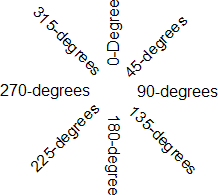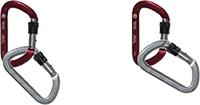
This also applies to cable, chain, and webbing.
Gear that is anchored includes anchors, rocks, trees, tripods, trucks, etc.
A "bight" is a simple loop in a rope that does not cross itself.
A "bend" is a knot that joins two ropes together. Bends can only be attached to the end of a rope.
A "hitch" is a type of knot that must be tied around another object.
"Descending devices" (e.g., ATCs, Brake Bar Racks, Figure 8s, Rescue 8s, etc) create friction as their primary purpose. The friction in descending devices is always considered when calculating forces.
The "Safety Factor" is the ratio between the gear's breaking strength and the maximum load applied to the gear (e.g., 5:1).
To rotate an item, select it and then click and drag just outside one of the selection corners.

If you press the Shift key while rotating gear, the rotation is constrained to 15° increments. (A program Option allows you to reverse the behavior of the Shift key during rotation.)
If you press the Ctrl key before clicking and rotating, gear that is connected to that gear will also rotate. That is similar to dragging gear while pressing the Ctrl key.
When multiple items are selected, you can rotate the selected items using the "rotator on a stick" that appears above the selected items. You can set a program Option that will cause the "rotator on a stick" to appear even when only one item is selected.
Gear that is locked cannot be rotated.
Watch a video that explains how to flip, resize, and rotate gear.
You can also change the rotation in the Appearance section of the properties pane.

The Default Size and Rotation command at the top of the properties pane (and in the gear's shortcut menu) resets the size, rotation, and opacity of the selected gear:

Rotated gear is based on 360 degrees with 0° at the top (12:00), 90° on the right (3:00), 180° at the bottom (6:00), and 270° on the left (9:00).

You can enter negative values to reverse the rotation. For example, entering -45 in the properties pane will rotate the item to 315°.
Some gear will connect to other gear regardless of the rotation angle (e.g., raft D-rings), some gear will connect over a broad range of rotation angles (e.g., anchors, loads, pitons, the left and right holes in rigging plates, etc), and some gear must be closely aligned (e.g., carabiners). The carabiners on the left were able to connect because they are closely aligned. The carabiners on the right did not connect because they are rotated differently.
